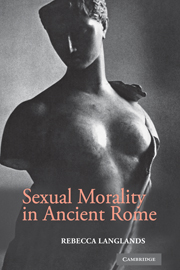Book contents
- Frontmatter
- Contents
- Acknowledgements
- Introduction
- Chapter 1 Sexual virtue on display I: the cults of pudicitia and honours for women
- Chapter 2 Traditional narratives and Livy's Roman history
- Chapter 3 Valerius Maximus: the complexities of past as paradigm
- Chapter 4 Subversive genres: testing the limits of pudicitia
- Chapter 5 Declamation: what part of ‘no’ do you understand?
- Chapter 6 Sexual virtue on display II: oratory and the speeches of Cicero
- Chapter 7 Imperial narratives, imperial interventions
- Conclusion
- Bibliography
- Subject index
- Index locorum
Chapter 1 - Sexual virtue on display I: the cults of pudicitia and honours for women
Published online by Cambridge University Press: 22 September 2009
- Frontmatter
- Contents
- Acknowledgements
- Introduction
- Chapter 1 Sexual virtue on display I: the cults of pudicitia and honours for women
- Chapter 2 Traditional narratives and Livy's Roman history
- Chapter 3 Valerius Maximus: the complexities of past as paradigm
- Chapter 4 Subversive genres: testing the limits of pudicitia
- Chapter 5 Declamation: what part of ‘no’ do you understand?
- Chapter 6 Sexual virtue on display II: oratory and the speeches of Cicero
- Chapter 7 Imperial narratives, imperial interventions
- Conclusion
- Bibliography
- Subject index
- Index locorum
Summary
pulcherrima … forma, maximum decus … pudicitia
The loveliest form of beauty … the greatest adornment … pudicitia
(Seneca to his mother Helvia)This book begins with a chapter about pudicitia as publicly celebrated and rewarded in Roman society. A striking aspect of pudicitia was its association with public and visual display by married women to the community, both through their appearance and demeanour and through their cultivation of pudicitia as a goddess. This first chapter explores the manifestation of pudicitia as a personified abstract virtue, a goddess described as playing an active role in the lives of ancient Romans, with her own shrines, cult statues and cult. It introduces key themes such as pudicitia's association with married women, public display, and the negotiation of the boundaries of social status. The chapter also exposes some of the tensions that lend this ideal of displaying pudicitia its frisson: its elusiveness; its dangerous proximity to, and strained relationship with, beauty; its fragility in the face of suspicion and gossip.
Pudicitia was a personal quality that needed to be displayed to and seen by others. Roman society demanded that a married woman (and particularly one involved in celebrating the cult of pudicitia) must strive to display the quality of pudicitia to the rest of the community in her person. Ideally pudicitia would shine forth from a married woman; it would turn heads when she walked down the street.
- Type
- Chapter
- Information
- Sexual Morality in Ancient Rome , pp. 37 - 77Publisher: Cambridge University PressPrint publication year: 2006
- 1
- Cited by



